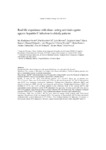Mostrar o rexistro simple do ítem
Real life experience with direct-acting antivirals agents against hepatitis C infection in elderly patients
| dc.contributor.author | Rodríguez-Osorio, Iria | |
| dc.contributor.author | Cid-Silva, Purificación | |
| dc.contributor.author | Morano, Luis | |
| dc.contributor.author | Castro-Iglesias, Ángeles | |
| dc.contributor.author | Suárez, Marta | |
| dc.contributor.author | Delgado, Manuel | |
| dc.contributor.author | Margusino-Framiñán, Luis | |
| dc.contributor.author | Meijide, Héctor | |
| dc.contributor.author | Pernas, Berta | |
| dc.contributor.author | Tabernilla, Andrés | |
| dc.contributor.author | Pedreira, José D. | |
| dc.contributor.author | Mena, Álvaro | |
| dc.contributor.author | Poveda, Eva | |
| dc.date.accessioned | 2017-04-17T10:53:03Z | |
| dc.date.issued | 2017-01-18 | |
| dc.identifier.citation | 61 | es_ES |
| dc.identifier.issn | 1386-6532 | |
| dc.identifier.issn | 1873-5967 | |
| dc.identifier.uri | http://hdl.handle.net/2183/18395 | |
| dc.description | Short communication | es_ES |
| dc.description.abstract | [Abstract] Background. New direct-acting antivirals agents (DAAs) are very safe and well tolerated. Objectives. The purpose of this study is to analyse the efficacy and safety of DAAs in elderly patients, who have co-morbidities and are on chronic medications. Study design. All HCV-infected patients over 65 years old in clinical follow-up at two Hospitals in Spain who initiated anti-HCV therapy were included (August 2012–October 2015). Results. A total of 120 HCV mono-infected patients were recorded. Mean age of patients was 72.6 ± 7.4 years. There were 53.3% women and GT1b was the most frequent (83.3%); 64.2% had cirrhosis and 42.5% were treatment experienced. Ombitasvir + Paritaprevir/r ± Dasabuvir ± Ribavirin (RBV) and sofosbuvir/ledipasvir ± RBV were the most frequently used regimens. Weight-adjusted dosing of RBV was included in 61.7% and 43.6% of them required a dose reduction. Most of the patients (86.7%) had concomitant chronic medication and in 35.8% adjustment was necessary. Adverse events (AE) were seen in 65% of the patients; more frequent when a protease inhibitor (PI) was being used. The sustained virological response (SVR12) per ITT was 88.3%. Only 3 patients discontinued treatment and 2 patients died. Conclusions. High rates of SVR12 (88.3%) were observed among elderly patients with DAAs-based regimens. The presence of AE was frequent (65%). The majority of these patients (86.7%) had concomitant medication that required adjustment in 1/3 of them. These findings highlight the high rates of response to DAAs in the elderly HCV-population. However, special caution must be taken when using RBV and a PI. | es_ES |
| dc.description.sponsorship | Instituto de Salud Carlos III; CPII14/00014 | es_ES |
| dc.description.sponsorship | Instituto de Salud Carlos III; PI10/02166 | es_ES |
| dc.description.sponsorship | Instituto de Salud Carlos III; PI13/02266 | es_ES |
| dc.description.sponsorship | Instituto de Salud Carlos III; CM15/00233 | es_ES |
| dc.language.iso | eng | es_ES |
| dc.publisher | Elsevier | es_ES |
| dc.relation.uri | http://doi.org/10.1016/j.jcv.2017.01.003 | es_ES |
| dc.rights | Atribución-NoComercial-SinDerivadas 3.0 España | es_ES |
| dc.rights.uri | http://creativecommons.org/licenses/by-nc-nd/3.0/es/ | * |
| dc.title | Real life experience with direct-acting antivirals agents against hepatitis C infection in elderly patients | es_ES |
| dc.type | info:eu-repo/semantics/article | es_ES |
| dc.rights.access | info:eu-repo/semantics/embargoedAccess | es_ES |
| dc.date.embargoEndDate | 2018-01-18 | es_ES |
| dc.date.embargoLift | 2018-01-18 | |
| UDC.journalTitle | Journal of Clinical Virology | es_ES |
| UDC.volume | 88 | es_ES |
| UDC.endPage | 58 | es_ES |
Ficheiros no ítem
Este ítem aparece na(s) seguinte(s) colección(s)
-
INIBIC-VC - Artigos [37]






